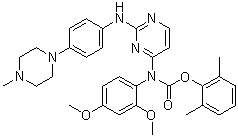WH-4-023 (also called KIN112; WH-4023; KIN-001-112) is a novel, potent, selective and orally bioactive inhibitor of Src family kinase (dual Lck/Src inhibitor) with potential anti-inflammatory and anticancer activity. It inhibits dual Lck/Src kinases with IC50s of 2 nM and 6 nM in cell-free assays, respectively. WH-4-023 increased LPS-stimulated IL-10 production and greatly suppressed proinflammatory cytokine secretion.
Physicochemical Properties
| Molecular Formula | C32H36N6O4 | |
| Molecular Weight | 568.67 | |
| Exact Mass | 568.279 | |
| CAS # | 837422-57-8 | |
| Related CAS # |
|
|
| PubChem CID | 11844351 | |
| Appearance | White to off-white solid powder | |
| Density | 1.2±0.1 g/cm3 | |
| Boiling Point | 743.2±70.0 °C at 760 mmHg | |
| Flash Point | 403.3±35.7 °C | |
| Vapour Pressure | 0.0±2.5 mmHg at 25°C | |
| Index of Refraction | 1.637 | |
| LogP | 3.42 | |
| Hydrogen Bond Donor Count | 1 | |
| Hydrogen Bond Acceptor Count | 9 | |
| Rotatable Bond Count | 9 | |
| Heavy Atom Count | 42 | |
| Complexity | 826 | |
| Defined Atom Stereocenter Count | 0 | |
| InChi Key | NBTNHSGBRGTFJS-UHFFFAOYSA-N | |
| InChi Code | InChI=1S/C32H36N6O4/c1-22-7-6-8-23(2)30(22)42-32(39)38(27-14-13-26(40-4)21-28(27)41-5)29-15-16-33-31(35-29)34-24-9-11-25(12-10-24)37-19-17-36(3)18-20-37/h6-16,21H,17-20H2,1-5H3,(H,33,34,35) | |
| Chemical Name | 2,6-dimethylphenyl (2,4-dimethoxyphenyl)(2-((4-(4-methylpiperazin-1-yl)phenyl)amino)pyrimidin-4-yl)carbamate | |
| Synonyms |
|
|
| HS Tariff Code | 2934.99.9001 | |
| Storage |
Powder-20°C 3 years 4°C 2 years In solvent -80°C 6 months -20°C 1 month |
|
| Shipping Condition | Room temperature (This product is stable at ambient temperature for a few days during ordinary shipping and time spent in Customs) |
Biological Activity
| ln Vitro | WH-4-023 and the 2-substituted version on Lck show comparable increases in potency [1]. | ||
| ln Vivo |
|
||
| Animal Protocol |
|
||
| References |
[1]. Novel 2-aminopyrimidine carbamates as potent and orally active inhibitors of Lck: synthesis, SAR, and in vivo antiinflammatory activity. J Med Chem. 2006 Aug 10;49(16):4981-91. |
||
| Additional Infomation | N-(2,4-dimethoxyphenyl)-N-[2-[4-(4-methyl-1-piperazinyl)anilino]-4-pyrimidinyl]carbamic acid (2,6-dimethylphenyl) ester is a member of piperazines. |
Solubility Data
| Solubility (In Vitro) |
|
|||
| Solubility (In Vivo) |
Solubility in Formulation 1: ≥ 0.77 mg/mL (1.35 mM) (saturation unknown) in 10% DMSO + 40% PEG300 + 5% Tween80 + 45% Saline (add these co-solvents sequentially from left to right, and one by one), clear solution. For example, if 1 mL of working solution is to be prepared, you can add 100 μL of 7.7 mg/mL clear DMSO stock solution to 400 μL PEG300 and mix evenly; then add 50 μL Tween-80 to the above solution and mix evenly; then add 450 μL normal saline to adjust the volume to 1 mL. Preparation of saline: Dissolve 0.9 g of sodium chloride in 100 mL ddH₂ O to obtain a clear solution. Solubility in Formulation 2: ≥ 0.77 mg/mL (1.35 mM) (saturation unknown) in 10% DMSO + 90% Corn Oil (add these co-solvents sequentially from left to right, and one by one), clear solution. For example, if 1 mL of working solution is to be prepared, you can add 100 μL of 7.7 mg/mL clear DMSO stock solution to 900 μL of corn oil and mix evenly. (Please use freshly prepared in vivo formulations for optimal results.) |
| Preparing Stock Solutions | 1 mg | 5 mg | 10 mg | |
| 1 mM | 1.7585 mL | 8.7924 mL | 17.5849 mL | |
| 5 mM | 0.3517 mL | 1.7585 mL | 3.5170 mL | |
| 10 mM | 0.1758 mL | 0.8792 mL | 1.7585 mL |
